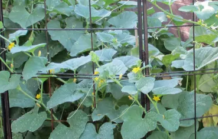https://hnr.k-state.edu/extension/info-center/newsletters/index.html
Blog Post: http://www.ksuhortnewsletter.org
Video of the Week: Storing Tender Bulbs for the Winter
https://kansashealthyyards.org/component/allvideoshare/video/storing-tender-bulbs-for-winter?Itemid=101
UPCOMING EVENTS
Kansas Turf & Landscape Conference
The 72nd Annual Kansas Turf & Landscape Conference will be held on Wednesday, November 30 and Thursday, December 1 at the Hilton Garden Inn, Manhattan. The conference is an excellent way to learn about turf and landscape management, visit with old friends, network with new ones, and see all the latest products and supplies from local and national vendors.
The conference has been approved for commercial pesticide recertification hours:
1 Core hour
3A – 7 hours
3B – 7hours
GCSAA education points and International Society of Arboriculture CEUS will also be available by attending the conference.
For more information, go to https://www.kansasturfgrassfoundation.com/
REMINDERS
• Continue to transplant trees and shrubs
• Harvest tomatoes and peppers when frost threatens
TURFGRASS
Control Broadleaf Weeds in Late October – Early November
Perennials are currently transferring sugar to the roots for storage. These reserves will provide energy for their survival during winter. Perennial weeds, including dandelions, go through the same process. Winter annual weeds such as henbit and chickweed are beginning to pop up and can easily be controlled while they are small.
Fall applications of herbicides, such as 2, 4-D or combination products (Trimec, Weed-B-Gon, Weed-Out) that contain 2,4-D, MCPP and Dicamba, are effective because the chemicals will be moved to the roots along with the sugars. It is important for the plants to be actively growing for herbicides to work.
It is best to apply herbicides when the outdoor temperature is 50 degrees F or higher. Weed Free Zone (also sold under the name of Speed Zone) contains the three active ingredients mentioned above, plus carfentrazone. It will give a quicker response than the other products mentioned especially as the temperature drops below 50 degrees F.
Weed control begins with prevention. Maintaining a healthy, dense lawn and mulching planters in early summer reduces the need for herbicides later in the year. Once weeds have germinated applying mulch is not as useful for control. Hand pulling young weeds is practical for small areas before the roots become established. (Cynthia Domenghini)
Why Late Lawn Seedings Often Fail
Planting lawns in late fall lowers the success rate of the seedlings because the roots are not established enough when freezing temperatures arrive. As the soil freezes and thaws repeatedly, the young seedlings are pushed out of the soil where they dry out and die.
It is recommended to establish tall fescue seed in September but no later than October 15 to give the seedlings enough time to develop roots. You may have success planting after this date, but it is less certain. Keep newly planted lawns watered through the fall and ensure even mature lawns are watered periodically. The soil should be moist going into winter. (Cynthia Domenghini)
Tucking Your Lawnmower in for the Winter
If you are done mowing for the year, be sure to service your mower before storing it away.
• Drain the gas tank of gasoline-powered engines or use a gasoline stabilizer.
• A few drops of oil squirted inside the spark plug hole (after you remove the spark plug) will help lubricate the cylinder.
• Replace the spark plug with a new one.
• If your equipment has a battery, clean the battery terminals, which usually corrode during the season. A wire-bristle brush is a good tool for doing this.
• Remove the battery and connect it to a battery maintainer to keep it charged over winter. Store in a protected location such as a cool basement.
• Sharpen mower blades following these steps:
o Check the blade for major damage and replace as needed.
o Remove grass and debris from the blade with a moist cloth. Dry before beginning to sharpen the cutting edge.
o Remove nicks from the cutting edge, using a grinding wheel or hand-file. If using a grinding wheel, match the existing edge angle to the wheel. If hand-filing, file at the same angle as the existing edge.
o Grind or file until the edge is 1/32-inch, about the size of a period. Sharpening to a razor edge may cause the edge to fold over during use resulting in a poor cut. Particularly with a grinding wheel, avoid overheating the blade as this may damage it.
o Clean the blade with solvent or oil for optimum winter storage. Avoid using water which promotes rust.
Getting these tasks done now will save you time in the spring and prolong the life of your equipment. (Cynthia Domenghini)
VEGETABLES
Hardiness of Cool-Season Vegetables
Not all cool-season vegetables tolerate our winter temperatures. Semi-hardy crops can withstand light frost but suffer damage when the temperature drops in the 20s. Chinese cabbage, collards, Irish potatoes, Bibb lettuce, mustard, radishes, spinach, Swiss chard and leaf lettuce are all examples of semi-hardy crops. Row covers can be used to help extend the harvest season of these crops.
“Hardy” vegetables such as: cabbage, broccoli, cauliflower, Brussels sprouts, carrots, turnips and kale can tolerate temperatures to the low 20s before they show signs of damage. Root crops including: beets, carrots, potatoes and turnips can be left in the ground beneath a layer of mulch after the leaves die back from frost. They can be harvested as needed until the soil begins to freeze in late November to December. (Cynthia Domenghini)
Keeping Your Pumpkin Longer
When selecting pumpkins for your home check for maturity by pressing your thumbnail into the rind. If the rind is hard and sounds hollow when thumped it was likely harvested at maturity. Pumpkins that are soft or haven’t developed a solid color will rot more quickly. Pumpkins harvested at maturity have a waxy coating that protects them from drying out. You can create this artificially using a spray wax which may help prolong the pumpkin’s life. Harvested pumpkins last longer if they are kept cool, which isn’t always a possibility when displayed outdoors during our extended summer weather days.
Carved pumpkins have a much shorter shelf-life, sometimes only a few days up to a week before noticeable rotting occurs. To extend the life of carved pumpkins be sure to clean out the inside thoroughly, removing all seeds and loose string. Soak the inside of the pumpkin in a 10 % bleach-water solution for several hours. Avoid using a real candle inside the pumpkin since the heat will speed up rotting. Pumpkins have a high water concentration, so if there’s a freeze in the forecast, bring your jack-o-lanterns inside. (Cynthia Domenghini)
FLOWERS
Winter Storage of Summer Bulbs
It may feel like this is the summer that won’t quit, but winter temperatures are bound to arrive eventually. With that in mind it’s time to consider how to protect the underground root structures of more sensitive plants such as gladiolus, caladium, dahlia, tuberous begonia, calla lily and canna lily. The storage organs or rooting structures of these plants are commonly referred to as bulbs. Actually, canna and calla lilies are rhizomes, caladium, and tuberous begonias are tubers, gladiolus is a corm, and dahlia is a tuberous rooted plant.
Each of these plants should be dug after the foliage has turned brown from frost. Allow them to dry for a week in a protected area such as a garage or shed. Clean the soil off the roots and pack them separately in peat moss, vermiculite or perlite. Rot can easily spread from one plant to another so keep the roots from touching during storage. Applying a fungicide to the roots can provide extra protection. Most of the plants will store best as close to 40 degrees F as possible. Caladiums need to be stored between 50- and 60-degrees F. (Cynthia Domenghini)
Contributors:
Cynthia Domenghini, Instructor and Horticulture Extension Specialist
Ward Upham, Extension Associate
Department of Horticulture and Natural Resources
1712 Claflin, 2021 Throckmorton
Manhattan, KS 66506
(785) 532-6173
For questions or further information, contact: cdom@ksu.edu, wupham@ksu.edu OR cdipman@ksu.edu
This newsletter is also available on the World Wide Web at:
http://hnr.k-state.edu/extension/info-center/newsletters/index.html
The web version includes color images that illustrate subjects discussed. To subscribe to this newsletter electronically, send an e-mail message to cdom@ksu.edu, cdipman@ksu.edu or wupham@ksu.edu listing your e-mail address in the message.
Brand names appearing in this newsletter are for product identification purposes only. No endorsement is intended, nor is criticism implied of similar products not mentioned.
K-State Research and Extension is committed to making its services, activities and programs accessible to all participants. If you have special requirements due to a physical, vision or hearing disability, or a dietary restriction please contact Extension Horticulture at (785) 532-6173.
Kansas State University Agricultural Experiment Station and Cooperative Extension Service K-State Research and Extension is an equal opportunity employer. Issued in furtherance of Cooperative Extension Work, Acts of May 8 and June 30, 1914, as amended. Kansas State University, County Extension Councils, and United States Department of Agriculture Cooperating, Ernie Minton, Dean.





